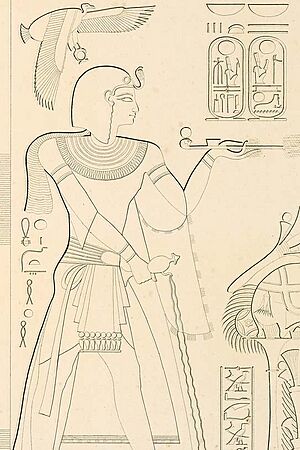Ramesses VII facts for kids
Quick facts for kids Ramesses VII |
|
|---|---|
| Ramses VII, Rameses VII | |

Ramesses VII from tomb KV1, drawn by Karl Richard Lepsius
|
|
| Pharaoh | |
| Reign | c. 1136–1129 BC (20th Dynasty) |
| Predecessor | Ramesses VI |
| Successor | Ramesses VIII |
| Children | Ramesses |
| Father | Ramesses VI |
| Mother | Nubkhesbed |
| Died | 1129 BC |
| Burial | KV1 |
Ramesses VII was an ancient Egyptian pharaoh. He was the sixth ruler of the 20th Dynasty. His full royal name was Usermaatre Setepenre Meryamun. This means "Rich in Maat like Ra, the chosen one of Ra, beloved of Amun."
Ramesses VII ruled Egypt for about seven years. His reign lasted from around 1136 BC to 1129 BC. He was the son of the pharaoh Ramesses VI.
How Long Did Ramesses VII Rule?
Historians believe Ramesses VII ruled for at least seven years. We know this from ancient Egyptian writings. These writings include papyrus documents and pottery shards called ostraca.
One important papyrus, called P. Turin Cat. 1883 + 2095, mentions his eighth year as king. This document talks about copper work being ordered. It also names two foremen from a village called Deir el-Medina. This papyrus helps us understand how long he was on the throne.
It seems Ramesses VII ruled for about 7 years and 5 months. Some experts think he might have ruled for almost 8 years. His time as pharaoh was a bit difficult. Prices for grain, which was a very important food, went up a lot during his reign.
Ramesses VII's Tomb
Ramesses VII was buried in a tomb known as KV1. This tomb is located in the Valley of the Kings. It was a special burial place for pharaohs.
However, his mummy has never been found. Only four small cups with his name on them were discovered. These cups were found in a hidden place called the "royal cache" in DB320. This cache held the remains of many other pharaohs.



